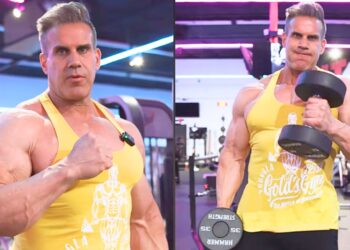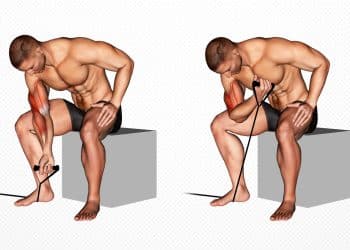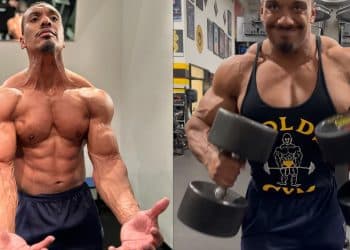Roll up your sleeves and take a look at your arms. Are you REALLY happy with the size of your biceps? Probably not! Despite all those barbell and dumbbell curls, your arms are still lacking that certain something that causes heads to turn and jaws to drop.
And no, we’re not talking about Synthol!
Most lifters want bigger, better-shaped biceps, and a steady diet of barbell and standard dumbbell curls probably won’t get the job done.
So, shake up your arm workout and bust your biceps out of their current training rut with pinwheel curls. This seldom-performed exercise could be the key to building the biceps of your dreams!
Pinwheel Curl – Muscles Worked
Pinwheel curls are an isolation exercise. That means they involve just one joint and a small number of muscles. The primary muscles involved in pinwheel curls are:
Biceps brachii
Known as the biceps for short, this is arguably the most well-known muscle in the human body. Located on the front of your upper arm, the biceps flex your elbow and shoulder joint and are also responsible for the supination of the forearm, meaning they turn your palm upward.
Level Up Your Fitness: Join our 💪 strong community in Fitness Volt Newsletter. Get daily inspiration, expert-backed workouts, nutrition tips, the latest in strength sports, and the support you need to reach your goals. Subscribe for free!
Biceps brachii means two-headed arm muscle, referring to the biceps having two separate origin sites and a single insertion. Of these two heads (long and short head), pinwheel curls emphasize the long head, which is located on the outside of the biceps.
Brachialis
The brachialis lies beneath the biceps, so it’s almost entirely out of sight. However, it still contributes greatly to your upper arm size and strength and helps “push up” your biceps to make it appear larger. The brachialis is responsible for the flexion of the elbow joint.
Brachioradialis
Located mainly in the lower arm, the brachioradialis is a forearm muscle that also flexes the elbow joint. It’s involved in the supination of the wrist, and well-developed brachioradialis muscles will give you thicker, more muscular forearms.
How to Do Pinwheel Curls
Get more from pinwheel curls while keeping your risk of injury to a minimum by following these guidelines:
- Hold a dumbbell in each hand and stand with your arms by your sides, palms facing your legs. Bend your knees slightly for balance, brace your core, and pull your shoulders down and back.
- Keeping your elbow close to your sides, bend one arm and curl the weight across the front of your body and up to your opposite shoulder.
- Lower the weight slowly back to your side and then repeat with the other arm.
- Alternate sides for the required number of reps or until you reach failure.
Tips:
- Place folded towels between your upper arms and ribs to encourage you to keep them tucked into your sides.
- Think about leading with your thumb.
- Lower the weights more slowly than you lift them to fully engage the target muscles.
- Lean forward slightly as you lift the weights and then stand up straight as you lower them to overload the eccentric portion of the exercise.
- This exercise works best with medium to light weights and moderate to high reps, e.g., 8-20.
Pinwheel Curl Benefits and Drawbacks
Not sure if pinwheel curls deserve a place in your arm workouts? Check out these benefits and then decide.
Low-tech but high effect
Arm exercises don’t come much more straightforward than pinwheel curls. After all, the only thing you need to do this exercise is a pair of dumbbells. As such, they’re ideal for anyone who trains in a basic gym, who doesn’t have access to machines, works out at home, or prefers a low-tech workout.
A total arm exercise
Want to train your biceps and forearms? Pinwheel curls are one of the best ways to do it. Do pinwheel curls to build stronger, more muscular biceps and forearms and a powerful grip in one straightforward exercise.
Good for variety
Doing the same exercises over and over can get boring fast. This affects not only your physical performance but your mental performance too. Adding pinwheel curls to your workouts will help boost muscle growth while making your workouts fresh and interesting.
Lift more weight
Compared to regular dumbbell curls and hammer curls, you should be able to use a little more weight with pinwheel curls. The position and angle of your arms is mechanically advantageous. Using more weight will lead to greater increases in strength, plus heavy weights are cool, man!
While pinwheel curls are a mostly beneficial exercise, there are also a few drawbacks to consider:
More elbow stress
Some people may find that pinwheel curls put more stress on their elbows and, in particular, the biceps tendon. If you are prone to biceps tendonitis, you may want to limit yourself to lighter weights and only do this exercise occasionally. You may even prefer to skip it entirely and use one of the joint-friendly provided alternatives below.
Read more about elbow pain and how to avoid it here.
An awkward movement
If you are used to doing regular barbell and dumbbell biceps curls, you may find pinwheel curls a little awkward, as the movement is quite unique. However, if you persevere, it will become more natural and comfortable.
No supination of the forearm
Pinwheel curls keep your wrists in a neutral position. To fully engage your biceps, your wrists need to supinate, meaning to turn your palms upward. As such, pinwheel curls are great for hitting your brachialis and brachioradialis but may not be the best exercise for the biceps and should be supplemented with a palms-up biceps exercise.
7 Pinwheel Curl Variations and Alternatives
Pinwheel curls are a highly effective upper arm and forearm exercise, but that doesn’t mean you need to do them all the time. There are several variations and alternatives you can use to keep your workouts productive and interesting:
1. Hammer curls
Hammer curls are basically pinwheel curls without the cross-body arm action. This means they work all of the same muscles, albeit from a slightly different angle. In fact, it’s safe to say that pinwheel curls and hammer curls are pretty interchangeable.
Steps:
- Hold a dumbbell in each hand with your arms by your sides and palms facing your legs. Tuck your upper arms into your ribs, pull your shoulders down and back, and brace your core.
- Without using your legs or back for assistance, bend your elbows and curl the weights up toward your shoulders. Do NOT rotate your wrists. Instead, make sure your palms face inward, i.e., a neutral position.
- Extend your arms, lower the weights back down to your sides, and repeat.
- You can curl both dumbbells up at once or, if you prefer, use an alternating arm action for this exercise.
Muscles targeted:
Primary: Biceps, brachialis, brachioradialis.
Secondary: N/A.
Benefits:
- An easy exercise to learn and master.
- It can be done with both arms simultaneously to save time.
- Just as effective as pinwheel curls.
Tips:
- Do hammer curls seated or standing as preferred.
- Think about leading with your thumbs to maximize muscle activation.
- Lean forward slightly as you raise the weights and then sit or stand upright as you lower them to emphasize the eccentric part of each rep.
2. Zottman curls
Zottman curls are an old-school exercise that combines hammer curls with reverse curls and regular biceps curls to create a very effective upper and lower arm builder. While this one does require a bit of extra coordination, if you’ve only got time to do one arm exercise, Zottman curls would be an excellent choice.
Steps:
- Stand with your feet shoulder-width apart, and knees slightly bent for balance. Hold a dumbbell in each hand by your sides, palms facing your legs. Make sure your torso is fully upright. Brace your abs.
- While keeping your upper arms close to your sides, bend your elbows and curl the weights up to your shoulders. As you raise the weights, rotate your wrists so that your palms are turned upward. Curl the weights all the way up until your biceps are fully contracted.
- Next, without lowering the weights, rotate your forearm, so your palms are now facing downward. This is called a pronated grip.
- Extend your arms and, keeping your hands pronated, lower the weights down towards the starting position. Repeat for the prescribed number of repetitions.
Muscles targeted:
- Primary: Biceps, brachialis, brachioradialis.
- Secondary: N/A.
Benefits:
- A comprehensive and time-efficient upper and lower arm workout.
- It can be performed seated or standing as preferred.
- A good exercise for improving coordination and a better mind-muscle connection.
Tips:
- This exercise works best when done with moderate to light weights for medium to high reps.
- Use fat grips for a more challenging workout.
- Hold your dumbbells with your thumb closest to the weight plates to maximize the resistance when rotating your wrists.
3. Reverse curls
The barbell reverse curl is a classic biceps and forearm exercise, and it’s popular for a reason – it really works! This exercise might be simple and old-school, but it’s one of the best ways to train your biceps and forearms simultaneously.
Steps:
- Hold a barbell with an overhand, shoulder-width grip. Pull your shoulders down and back, and brace your abs.
- Keeping your upper arms close to your sides, bend your elbows and curl the bar up to your chest.
- Slowly extend your arms and repeat.
- You can also do this exercise using an EZ barbell if preferred.
Muscles targeted:
- Primary: Biceps, brachialis, brachioradialis.
- Secondary: N/A.
Benefits:
- A simple yet effective total arm exercise.
- Good for building a more powerful grip.
- An accessible exercise as all you need to do it is a barbell.
Tips:
- Use a false or thumbless grip to increase the grip-building effect of this exercise.
- You can also do reverse curls using a cable machine.
- Use a thick bar or clip-on fat grips for a more challenging workout.
4. Plate curls
So, you are stuck in a gym where all the dumbbells and barbells are being used. How frustrating! Don’t worry, though; you can still train your biceps and forearms with nothing more than a single weight plate.
Steps:
- Stand with your feet shoulder-width apart. Bend your knees slightly for balance, pull your shoulders down and back, and brace your core. Hold a weight plate so your hands are directly opposite one another, i.e., the “quarter to three” position.
- With your upper arms tucked in close to your sides, bend your arms and curl the weight plate up to your chest. Do not use your legs or back to help you swing the weight up.
- Lower the weight plate back down, making sure you control the descent until your arms are straight, and continue for the desired number of reps.
Muscles targeted:
- Primary: Biceps, brachialis, brachioradialis.
- Secondary: N/A.
Benefits:
- You only need a single weight plate to do this exercise.
- Good for building a stronger grip.
- An excellent alternative to hammer and pinwheel curls.
Tips:
- Squeeze your upper arms into your sides to maximize arm muscle engagement.
- You can also do plate preacher curls for variety.
- Use two plates and release one as you hit failure for a pump-inducing drop set.
Level Up Your Fitness: Join our 💪 strong community in Fitness Volt Newsletter. Get daily inspiration, expert-backed workouts, nutrition tips, the latest in strength sports, and the support you need to reach your goals. Subscribe for free!
5. Cable hammer curls
The great thing about cable exercises is how they keep your muscles under near-constant tension. This makes every rep you perform more effective and usually results in a deep burn and skin-splitting pump. Finish your arm workout with a few sets of cable hammer curls to see what we mean!
Steps:
- Attach a rope handle to a low cable machine. Hold one end in each hand with your thumbs pressed up against the stoppers/knots at the end of the rope.
- Stand with your feet about shoulder-width apart, arms tucked into your sides, and core braced.
- Without rotating your wrists, bend your arms and curl the handles up to your shoulders.
- Extend your arms and repeat.
Muscles targeted:
- Primary: Biceps, brachialis, brachioradialis.
- Secondary: N/A.
Benefits:
- Cable hammer curls are perfect for drop sets.
- Work all your major arm muscles in one straightforward exercise.
- An easy exercise to learn and master.
Tips:
- This exercise works best when done with light weights for high reps and short rests between sets.
- Grip the thick ends of the rope handles to increase the forearm and grip demand of this exercise.
- Keep your thumbs pointing up to emphasize your brachialis and brachioradialis muscles.
6. Neutral grip chin-ups
No, you haven’t accidentally clicked on a back-training article by mistake! While chin-ups are most definitely a lat exercise, using a neutral grip means it’s also a great way to train your biceps and forearms. This is an excellent option when you are short on time but still want to train all your major back muscles, as well as your biceps, brachialis, and brachioradialis.
Steps:
- Grip the neutral/parallel handles so your palms face inward. Hang with your arms straight and feet clear of the floor. Pull your shoulders down and back, and brace your abs.
- Without kicking or swinging, bend your arms and pull yourself up until your chin is above your hands. Keep your elbows down, back, and tucked into your sides.
- Slowly extend your arms and repeat.
Muscles targeted:
- Primary: Latissimus dorsi, mid and lower trapezius, rhomboids, rear deltoids.
- Secondary: Biceps, brachialis, brachioradialis.
Benefits:
- An effective way to really overload all your pulling muscles, including the biceps and forearms.
- A challenging exercise for intermediate and advanced exercisers.
- One of the best exercises for building functional upper-body strength and muscle mass.
Tips:
- Make this exercise more demanding by wearing a weighted vest or using a chin/dipping belt.
- Loop a resistance band over your pull-up bar and stand or kneel in it to make this exercise easier.
- Can’t do neutral grip chin-ups? Try neutral-grip inverted rows instead. They’re easier because your feet remain on the floor, so you don’t have to lift your entire body weight.
7. Hammer concentration curls
If you tend to swing your weights up when you’re doing curls, this is the exercise for you. It’s all but cheat-proof and keeps your muscles under constant tension. On the downside, you won’t be able to use as much weight, so it’s not so good for building brute strength.
Steps:
- Sit on an exercise bench with a dumbbell in one hand. Lean forward, place your triceps against your leg, and let your arm hang straight down from your shoulder. Rotate your wrist so that your thumb is pointing forward.
- Without turning your wrists, bend your elbow and curl the weight up to your shoulder.
- Extend your arm and repeat.
Muscles targeted:
- Primary: Biceps, brachialis, brachioradialis.
- Secondary: N/A.
Benefits:
- A very strict biceps and forearm exercise.
- Very little lower back stress.
- Train one arm at a time to address any left-to-right strength or size imbalances.
Tips:
- Lead with your thumbs to maximize brachialis and brachioradialis engagement.
- Press your triceps against your inner thigh to isolate your biceps and forearms more effectively.
- Use your free arm to spot your working arm for forced reps and a more intense workout.
Learn more about concentration curls
Pinwheel Curl FAQs
Do you have questions about pinwheel curls or biceps training in general? No worries; we’ve got the answers!
1. How many reps and sets of pinwheel curls should I do?
It’s generally accepted that, to build muscle, you should do between 10-20 sets per week to build a muscle or muscle group (1). You can do all the sets in one workout or spread them across several workouts as preferred.
For reps, anywhere from 6-35 will lead to muscle growth, providing you take your sets close to failure. However, to save time and make your workouts more efficient, it’s often best to limit your workouts to 20 reps or less per set.
But, if you want to build strength, heavy weights and low reps work best, and most of your training should be done in the 3-5 rep range.
Read more about sets, reps, and training to failure in this article.
2. How often should I train my biceps?
It’s generally best to train your biceps twice a week, e.g., Monday and Thursday. This will save you from having to cram all your sets into a single workout. Also, doing fewer sets in a workout means you’ll be able to train harder, which may lead to better results.
You CAN train your arms once per week, but more frequent workouts are usually more effective. Delayed onset muscle soreness is also less severe when you work out more often.
3. Some biceps exercises hurt my elbows. What should I do?
If an exercise causes pain, you should stop doing it. But, of course, we’re talking about elbow pain, as intense training is sure to make your muscles burn!
If you are experiencing elbow pain, make sure you are doing the exercise correctly, as improper exercise form will put stress on your joints. Next, make sure you aren’t using too much weight.
Finally, if an exercise still bothers your elbows, switch to an alternative that doesn’t cause joint pain. Some exercises are harder on your joints than others, and it could be that the movement you’re doing simply doesn’t suit you.
4. Can I build bigger arms without training the rest of my body?
It’s rarely a good idea to train just one or two body parts and leave the rest of your muscles undeveloped. So, while you COULD train your arms and skip the rest of your body, it’s not something we recommend.
For a start, your arms will look pretty weird if they’re hanging from narrow shoulders and your chest and back are small.
So, by all means, emphasize your arms, but don’t neglect the rest of your body. As well as creating a more aesthetically pleasing physique, this will probably enhance your arm workouts.
5. What should I eat to build bigger arms?
It’s beyond the scope of this article to tell you exactly what to eat for muscle growth. That’s a HUGE topic! However, here are some tips to make sure that your diet supports your muscle-building workouts.
- Consume around one gram of protein per pound of body weight for muscle repair and growth. Good protein sources include meat, fish, eggs, dairy, nuts, seeds, and whey protein powder.
- Eat plenty of nutrient-dense whole foods and limit your intake of nutritionally-poor junk food.
- Create a 300-500 per day calorie surplus, so you’ve got plenty of energy for training, recovery, and muscle growth.
- Drink plenty of fresh water to stay hydrated.
- Use whey protein, creatine, amino acids, pre-workouts, and other supplements to maximize your training and enhance recovery.
Learn more about muscle-building nutrition here!
6. What is the best way to build bigger arms naturally?
The most critical training principle for building muscle naturally is consistency. One workout won’t do it, and even months of training probably won’t produce the results you want. Instead, you need to hit the gym 3-5 times a week, every week, for months or even years at a time.
So, the best way to build bigger arms naturally is to not skip workouts. Commit to your training, work hard, eat right, get plenty of sleep, and your arms WILL grow!
7. How quickly will my arms grow once I start training them properly?
Beginners tend to increase muscle size and strength pretty quickly. If you are new to working out, you should see improvements in your appearance and strength within a few weeks. However, your rate of progress will also depend on your diet and how you manage things like rest and recovery.
Most experienced lifters with years of training under their weightlifting belts make progress more slowly, as they’re much closer to their genetic potential.
Pinwheel Curls – Wrapping Up
You probably won’t see many people doing pinwheel curls, and that’s a shame. This lesser-known arm exercise is great for building your biceps, brachialis, and brachioradialis. It’ll also strengthen your grip.
But, as good as pinwheel curls are, your muscles will soon adapt and plateau if you do them too often. So, add them to your favorite arm workout, but don’t feel you need to do them all the time.
The good news is there are plenty of equally effective exercises you can do in addition to or instead of pinwheel curls. Keeping your workouts varied will help prevent progress roadblocks and ensure your arms keep on growing year after year.
References:
1– PubMed: Total number of sets as a training volume quantification method for muscle hypertrophy: a systematic review https://pubmed.ncbi.nlm.nih.gov/30063555/
Interested in measuring your progress? Check out our strength standards for Dumbbell Curl, Pull Ups, Preacher Curl, and more.








